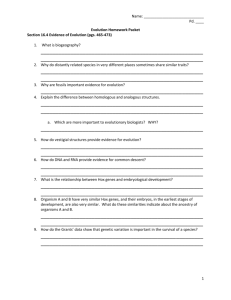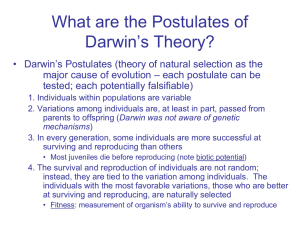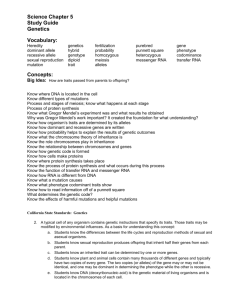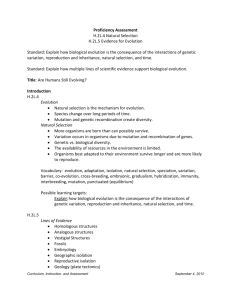Chapter 16 Population Genetics and Speciation Section 1 Genetic
advertisement
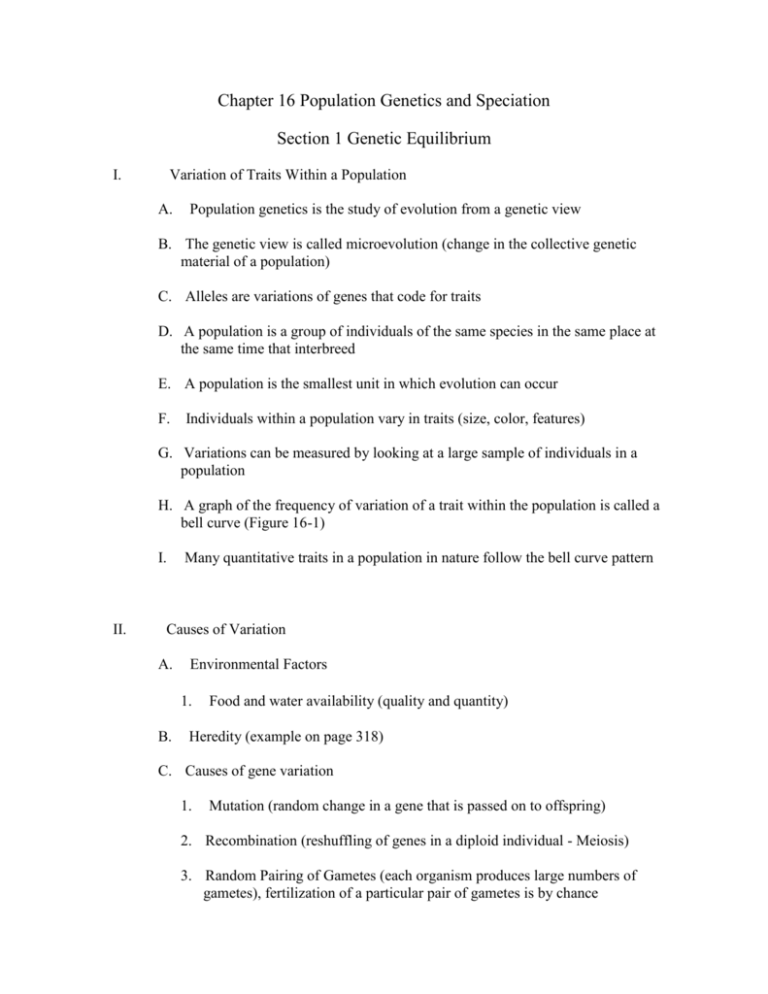
Chapter 16 Population Genetics and Speciation Section 1 Genetic Equilibrium I. Variation of Traits Within a Population A. Population genetics is the study of evolution from a genetic view B. The genetic view is called microevolution (change in the collective genetic material of a population) C. Alleles are variations of genes that code for traits D. A population is a group of individuals of the same species in the same place at the same time that interbreed E. A population is the smallest unit in which evolution can occur F. Individuals within a population vary in traits (size, color, features) G. Variations can be measured by looking at a large sample of individuals in a population H. A graph of the frequency of variation of a trait within the population is called a bell curve (Figure 16-1) I. II. Many quantitative traits in a population in nature follow the bell curve pattern Causes of Variation A. Environmental Factors 1. B. Food and water availability (quality and quantity) Heredity (example on page 318) C. Causes of gene variation 1. Mutation (random change in a gene that is passed on to offspring) 2. Recombination (reshuffling of genes in a diploid individual - Meiosis) 3. Random Pairing of Gametes (each organism produces large numbers of gametes), fertilization of a particular pair of gametes is by chance D. Some genes are expressed due to the presence or absence of other genes or factors in the environment III. The Gene Pool A. The gene pool is the total genetic information available in a population B. Allele Frequency is determined by dividing the number of a certain allele by the total number of alleles of all types in the population C. Predicting Phenotypes (physical characteristics) 1. Phenotype frequency is equal to the number of individuals with a particular phenotype divided by the total number of individuals in the population 2. Figure 16-3 page 319 IV. Hardy-Weinberg Genetic Equilibrium A. Genotypic frequencies within a population tend to remain the same from generation to generation unless acted on by outside influences B. Assumptions of the Hardy-Weinberg Genetic Equilibrium, Theoretically Speaking 1. No net mutations occur; that is, the alleles remain the same 2. Individuals neither enter nor leave the population 3. The population is large 4. Individuals mate randomly 5. Selection does not occur C. Real populations, hard to meet all conditions D. The principle allows one to consider what forces disrupt genetic equilibrium Section 2 Disruption of Genetic Equilibrium I. Mutation A. Spontaneous mutations occur constantly, at low rates under normal conditions B. Mutation rates can increase due to organism exposure to mutagens (mutationcausing chemicals and radiation) C. Mutations can produce totally new alleles for a trait D. Some mutations are harmful and others have no effect E. It is a slow process to eliminate harmful recessive mutations via natural selection on gene expression F. II. Beneficial mutations are a vital part of evolution Gene Flow A. Immigration (into the population) and emigration (out of the population) of individuals moves their genes into and out of the population too B. Baboon example page 321 C. Gene flow is the process of genes moving from one population to another D. Can occur through different mechanisms III. Genetic Drift (Figure 16-5, page 322) A. The phenomenon by which allele frequencies in a population change as a result of random events, or chance B. In small populations, allele frequency is easily disrupted (one fails to reproduce, or one reproduces quite often) C. Mechanism for the evolution of new species D. The smaller the population = large degree of genetic drift E. The large a population = smaller degree of genetic drift IV. Nonrandom Mating A. Individuals select a mate by geographic proximity, related individuals (amplify certain traits and cause disorders in offspring), that has similar traits to their own traits (assortative mating) B. Sexual Selection is female tendency to choose males they mate with based on certain traits 1. Bird example page 323 C. Natural selection acts upon differences in survival and reproduction D. It also favors an increase in the genes of successful reproducers, rather than those that are survivors V. Natural Selection A. Ongoing process in nature that operates on variations of traits within a population (size and color) B. Some members of a population are more likely than other members to survive and reproduce and contribute their genes to the next generation C. Three general patterns of natural selection (Figure 16-8 page 325) variation of the bell curve 1. Stabilizing Selection a. Individuals with the average form of a trait have the highest fitness; optimum for most traits b. Ends of the curve have a lower fitness (extreme forms) c. Most common kind of selection d. Operates on most traits and results in similar morphology between most members of a species 2. Disruptive Selection a. Individuals with either extreme variation of a trait have greater fitness than individuals with the average form of the trait b. Shell color example 3. Directional Selection a. Individuals that display a more extreme form of a trait have greater fitness than individuals with an average form of the trait Section 3 Formation of Species I. The Concept of Species A. Speciation = species formation (closely related species) B. Some species are similar to ancestral species and others are different over time C. Morphology = the internal and external structure and appearance of an organism (classification importance) D. Species were defined by structure and appearance E. Limitations 1. Phenotypic differences among individuals in a single population 2. Some organisms that appear different enough to belong to different species interbreed in the wild and produce fertile offspring F. Biological Species Concept (Mayr) – a species is a population of organisms that can successfully interbreed but cannot breed with other groups 1. Limitations include providing a definition of species for extinct organisms and asexual organisms G. Definition of species includes both morphological and biological species concepts 1. A species is a single kind of organism 2. Members of a species are morphologically similar and can interbreed to produce fully fertile offspring II. Isolation and Speciation A. Speciation is driven by isolation B. In isolation, two parts of a formerly interbreeding population stop interbreeding C. Geographic Isolation 1. The physical separation of members of a population a. Geographic barriers – canyons, mountains, water, desert b. Parts of a population can be transported to new islands or slowly drift apart on separate continents c. Geology frequently rearranges populations 2. Original habitat is divided 3. Once subpopulations are separated, gene flow between them stops 4. Natural selection and genetic drift cause the two subpopulations to diverge (become incompatible to mate) and become separate species (Figure 16-10 page 327) 5. Animal movement can also affect isolation (squirrel example) D. Allopatric Speciation occurs when species arise as a result of geographic isolation 1. Since two separated populations no longer experience gene flow between them; the gene pools may differ due to genetic drift, mutations, and natural selection 2. More likely to occur in small populations (smaller gene pool affected significantly by genetic drift and natural selection E. Reproductive Isolation results from barriers to successful breeding between population groups in the same area 1. May arise through disruptive selection 2. Prezygotic (premating) isolation = before fertilization a. Reduce the chance of hybrid formation b. Mating call recognition and mating times 3. Postzygotic (postmating) isolation = after fertilization (you want healthy, fully fertile offspring) a. F. Sympatric Speciation occurs when two subpopulations become reproductively isolated within the same geographic area (Darwin 1850’s) 1. III. May not develop completely, die early, or are sterile Competing individuals within a population could gain adaptive advantage by using different niches, this could lead to reproductive isolation Rates of Speciation (Figure 16-14 page 330) A. Gradualism – speciation occurs at a regular, gradual rate B. Punctuated equilibrium – speciation occurs in bursts relative to the geologic time scale (example fossil record), exist with no change for a long time, then great diversity results



